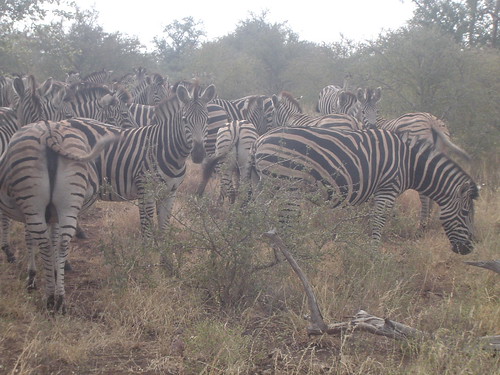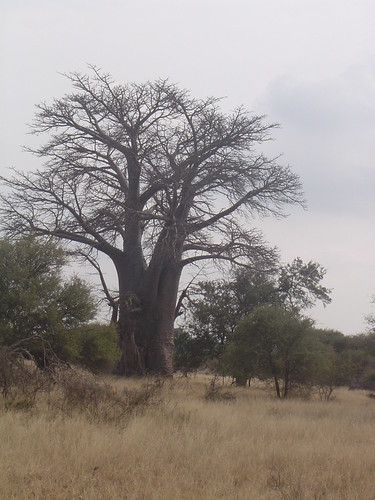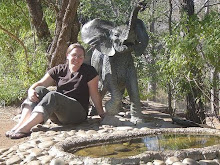It took us a couple hours of driving to get to the brand new border post, Giriyondo, that connects South Africa with Mozambique through Kruger Park. As we drove further west, the habitat looked more and more like the Kruger we know as we left the villages and people behind.
We saw many steenbok and duiker (small antelopes) that would dart away as we trundled past.
The land was dominated by mopane and marula trees and while it was dense bush, at times it would open up into incredible views stretching out to the horizon. Marula trees were starting to lose their leaves for winter, but mopane leaves turn yellow and then a lovely rust color. Not as striking perhaps as New England, but still very, very lovely!
We only passed one other vehicle as we drove along, kicked up clouds of dust. Just a few kilometers from the border we came across a herd of zebra -- now THIS was exciting!!! Our very FIRST sighting of zebra (of any large wildlife for that matter) actually in the wild in Mozambique! I took a picture of them (will have to get it up on here) ...and shortly after seeing them, we saw impala and wildebeest and began to see spoor (footprints, dung, etc.) of other animals. Kruger was near!!!

The border was deserted when we arrived. The guys inside the immigration seemed glad to see us -- someone to talk to!! We took care of immigration forms, etc. etc. and proceeded on to the South African side and then... we were through!!
The mopane and marula trees continued, but now we were driving up the Lebombo hills and there were beautiful white seringa trees, large spreading trees with very striking white trunks and bright yellow leaves -- they grow along the tops of rocky outcrops. Baboons and monkeys like to sit in them. There were the large baobab trees (known as "upside-down trees") towering here and there above the rest of the trees. We didn't see too many animals at first, but the landscape itself was so very interesting and varied that we really didn't mind much. We did begin to see what we call "the usual stuff" ... impala, wildebeest, warthogs, giraffes, zebras, waterbucks, kudus, etc.

Baobab "Upside Down" Tree
We saw several elephants and came upon one who was meandering down the road in front of us. We had to slow down and just creep along behind him, waiting for him to move off the road (after all, animals DO have the right of way in Kruger and besides, there really isn't much you can do when an enormous elephant bull thinks he owns the road!)
We drove to Letaba Restcamp, a beautiful camp (where my parents spent their honeymoon actually!). The camp is situated along the Letaba River and is full of large, beautiful shade trees like the Natal Mahogany, Sycamore Fig, Fever trees, etc. with bushbuck wandering about -they are so used to people you can almost pet them! We pulled in at the shop there just to stock up on some charcoal, some milk and other necessities, before filling up with gas and heading south to the Satara Camp where we would be spending the next two nights.
As we drove away from Letaba and made for Satara. Once we crossed the Olifants River - a very wide, rocky riverbed, full of sun-bathing hippos and crocs, the Lebombo hills veered off to our left and we left the mopane trees behind. Now the terrain was the more even ground of the grassy plains in the central part of Kruger. It is here that the migrating herds come in winter and we saw herds and herds of wildebeest and zebra. There were lots of large birds (ostriches, ground hornbills and secretary birds) striding along through the long, blond grass.
We saw lots of elephants as well, but interestingly they were all spaced out --not together as usual -- but I think it was because they were feeding without any particular destination in mind. Elephants communicate using infrasound and so distance isn't a big deal for them, they can communicate with each even though they are several kilometeres away from one another!
We arrived in Satara at last. Unlike most camps, it doesn't border along a river and the camp is pretty dry compared to the others -- there aren't any really large shade trees here. We went to the campground to find a spot, but because it was towards the end of the day, all the prime spots were taken! :o( We had thought that because schools in South Africa are still in session that things might be quieter, but that's what all the older South Africans figured on too! They were all there in the campers and caravans. In fact the park was full of elderly Afrikaaner people! They all assumed that since we were camping too that we must be locals and would greet us in Afrikaans. I'd greet back in English but by the end of it, I was just greeting them back in Afrikaan! ;o) We found a nice little spot under an acacia tree, about halfway between a little kitchen area and the bathrooms and set up camp. That night, after dinner we went to watch a film (just like what they used to do in the olden days -- well, when I was little anyway! They had discontinued it for a long time). The films are always wildlife documentaries (which I love!). That night it was all about hyenas. Very interesting!! After that, we picked our way along in the moonlight back to our tent and turned in soon after, waking up around 2AM to hear lions roaring back and forth. It sounded like one lion (male perhaps from the sound of him) was north of the camp and the rest of the pride was to the south. They called and answered at least 22 times! It was amazing to lie there and listen...I thoroughly enjoyed it!! (I wasn't nervous at all because lions' roars carry for a very far distance.) I finally drifted off to sleep again, dreaming of what we might see the next day....




No comments:
Post a Comment